The GOLD project newsletter covers scientific and technological developments in forestry and soil preservation. Here are brief summaries of the topics that have been researched:
- In forests at risk of fire, thinning residues are sometimes burned to reduce the combustibility of the area. What is the impact on soil biodiversity, and how can this be measured? Studies have found that the impact on arthropod populations is negligible.
- Another article reviews the scientific literature on the various roles and applications of dead wood. Many different, sometimes contradictory, policies are related to dead wood. The authors suggest transdisciplinary collaboration to identify trade-offs between biomass uses while ensuring the maintenance of functional forest ecosystems.
- Debarking significantly reduces the number of bark beetles that emerge from logs, while preserving the species richness of this beetle community.
- Compaction reduces the hydraulic conductivity and water retention capacity of saturated soil. A model can predict these hydraulic properties based on soil texture and the intensity of machine traffic.
- The proportions of carbon, nitrogen and phosphorus, as well as enzymatic activity, vary significantly between species (studies on different monospecific stands). These differences are particularly pronounced between hardwoods and softwoods.
- Soil temperature measurements provide information on the percentage of organic matter in the soil and its rate of decomposition. Tested in eucalyptus plantations in northwestern Spain, these measurements revealed that brush clearing and thinning lead to a decrease in the amount of organic matter in the soil by facilitating microbial respiration.


